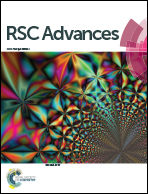Liquid photonic crystal detection reagent for reliable sensing of Cu2+ in water†
Abstract
A traditional hydrogel photonic crystal sensor is prepared by multiple steps, including colloidal assembly, polymerization, and recognition group modification, and its measurement repeatability is a challenge due to the inevitable deviations in sensor fabrication and application. In this work, a salicylic acid-containing “SiO2/propylene carbonate” liquid photonic crystal (Sal-LPC), as a new photonic sensing material, was developed to demonstrate reliable measurement of Cu2+ in water. When the Sal-LPC reagent was mixed with the test sample, the Cu2+ promoted the release of H+ from Sal and shrank the photonic crystal lattice, so that the Cu2+ concentration could be determined by the reflection blueshift of liquid PC. The Sal-LPC reagent showed a stronger response to Cu2+ than to other cations, and its sensitivity and measurement range could be optimized by the particle fraction and Sal dosage. Compared to traditional PC hydrogel sensors, the liquid PC reagent was composed of colloidal particles and responsive species, which required no strict control in synthesis. More importantly, the optical response of the liquid PC reagent was scarcely affected by changes in synthesis, storage, or application, and it could interact with the analyte quickly and quantitatively, which ensured accurate and repeatable measurement in either chemical analysis or environmental monitoring.



 Please wait while we load your content...
Please wait while we load your content...